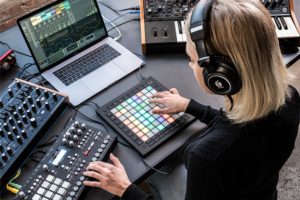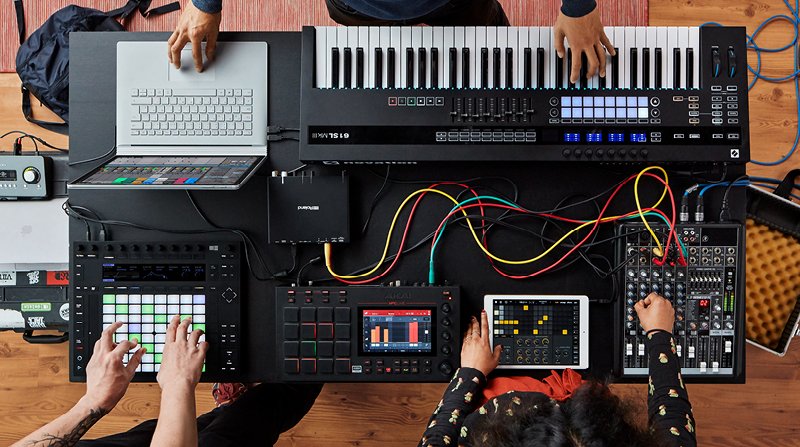How To Have Fun Making Music
Sometimes making music can be a chore. To people on the outside looking in, music seems like an enthralling, exciting, fun experience, but anyone who is a composer knows that making music takes focus, dedication, and frankly, at times, can be pretty boring, and stay boring. That’s why it’s important to know some techniques for how to have fun making music, just in case you fall into one of these creative ruts. What I’m about to share isn’t the definitive way for how to have fun making music, but rather things that I have done for a while that take the pressure off, and just allow me to be creatively expressive without all of the arduous parts.
Having The Ideal Setup Does Not Guarantee Fun Or Even Ease
I have written about this to death, but it deserves to be mentioned again. So many creatives think that they need the perfect setup in order to have fun. They think they need that new module for their Eurorack, or that new audio interface, or the latest poly-synth, and then, and only then, will they have the ideal creative experience. This is just so, so untrue. Every new piece of gear you get has a learning curve.
Unfortunately, the world of electronic music is not entirely standardized, so things won’t be immediately intuitive even if they are relatively similar to something you’ve already owned. Chances are that thing you already owned will allow for easier, more fun creative expression since you already know it. But, the cognitive fallacy that new equals good is just that, a fallacy. There is even a term for it in cognitive psychology – “appeal to novelty.”
Therefore, if you really want to know how to have fun making music, use my first advice would be to use something familiar.
Work With Loops
Go on Loopcloud and just start grabbing loops. The more complete the loop, the better. The goal here isn’t to make something super original, the goal here is to have a good time making music. Now drop those loops into session view in Ableton, and start triggering loops and see what happens. Maybe MIDI map some basic effects like delay, reverb, flanger, gate, pitch bend, and a filter. Then MIDI map the volume faders on the clip’s channels. Then start triggering loops! Fade the clips in and out, change the wet-dry on the effects, bend the pitch, and make the sound melt. Think of it kind of like DJing, but in a compositional sense.
Loopcloud Makes Everything Easy
Working with Loopcloud makes the process of choosing clips easier, as they have built-in search filters and algorithms that help identify contextually similar loops for you to play around with. All you have to do is click “find similar sounds” and Loopcloud can filter to you either harmonically or rhythmically similar sounds that will work well together. Then, with their native plugin, you can load the samples directly into the DAW without having to download the files, and sort them, allowing for seamless integration, and immediate use.
Another great thing is that this quick sorting loop function teaches you how to have fun making music that’s not the same as what you’d normally make. Maybe you’re a minimal house DJ, but you have a penchant for disco house – yet not a lot of experience with it. Well, with loops, it’s easy to throw together something that sounds good without the time or practice it takes to create something from scratch.
THis Isn’t About Art, It’s About Fun
Some people might take artistic integrity into question here, but we’re having fun, not creating our magnum opus. If you can’t get over that, think of it like DJing. When you’re DJing, you’re not only playing your music, your play other people’s music, just like other people made these loops. However, what you create will ultimately be more unique, and also royalty-free.
You may even like it and use it later in a more serious composition, but for now, the goal is to figure out how to have fun making music.
How To Have Fun Making Music With An Artificial Crowd
An artificial crowd, you say, Pheek? Yes, an artificial crowd! In this day and age, we have access to a plethora of crowds that will dance no matter what we do! How, you ask? Simple, by putting on YouTube videos of dancing crowds, and jamming to them. They don’t care what you do, they’re going to have a good time anyways! So, load up your smart TV, your projector, or even an auxiliary computer screen, load up a long video of people gyrating to some 90’s acid house, put that shit on mute, and start jamming.
Just Start Jamming
Better yet, keep the audio playing on the video of the crowd dancing, load up your favorite gear, and start jamming over it, like you’re just an accompaniment instrument to the mix. If you’re really fancy, you can route the audio through Ableton using a virtual audio cable. You can add fills of effects, tap in drum patterns, play auxiliary basslines or leads, load in some samples from Loopcloud! Basically, whatever your imagination can conjure on the fly, do it! Just make sure you press record.
Then once you’ve recorded all of these, you’ll have a fresh sample bank of new ideas that you can incorporate into fresh productions. Now, all that fun time was actually spent being productive, rather than frivolously. You also got some solid practice in!
I’ve been doing this technique for 15 or so years, and it has lead to a plethora of new material and inspiration.
Download A Ton Of Plugin Demos
This is a fun one. Basically, download the demos of a bunch of plugins that you would otherwise not use. Then grab a loop, or sound from somewhere, or make one quickly from scratch. Then load in the plugins, and start stacking them on top of each other and see what happens. Start flicking through presets on all of them, adjust knobs, and create massive, cacophonies of sound. Now filter those sounds, and see what happens. Maybe resample them, and then throw more plugins on top, while dropping the pitch.
How My Follows Have Fun Making Music
lotech/hijack says, “Honestly I find exploring and experimenting makes it fun. Don’t approach it as a process. Just remember that you love music and the feelings you get as a listener. Then go at it with that mindset. Works for me (usually).”

Camilo Jesus Ramirez says, “After years of making music I get the most of me when I don’t push myself to do it, I only do music when i feel to, sometimes I don’t touch a project in months and sometimes everyday non-stop, the fun comes when I feel in the mood”

Steve Moss laments, “Every time I buy new gear or a new synth I tell my wife: ok now I’m complete. My wife tells me: that’s what you say every time and you’re never complete! Hahaha.”

Pierre Deniel simply replies, “LSD.” I guess that’s one way too.

There Are Many Ways To Know How To Have Fun Making Music
There are many ways to have a fun, enthralling musical experience that doesn’t involve thinking too deeply, or seriously about the process.
To reiterate, it all starts with having something that you don’t have to troubleshoot too much. It’s easy for the fun to be sucked out if you have to spend your time learning, or fixing something. Therefore, start on gear you’re familiar with.
The next step to having fun is to try something without expectation. Don’t be afraid of dabbling in new genres, especially with an amazing tool like Loopcloud which allows you to load in, find, and sort samples in a heartbeat.
Don’t be afraid to try new plugins either, and do things that don’t make sense. At the end of the day, nobody really cares how you made something, as long as you make it.
The real magic here is that if you record it, you’ll be left with so much unique stuff that you can use in your future work. Never underestimate the usefulness of just having fun.


